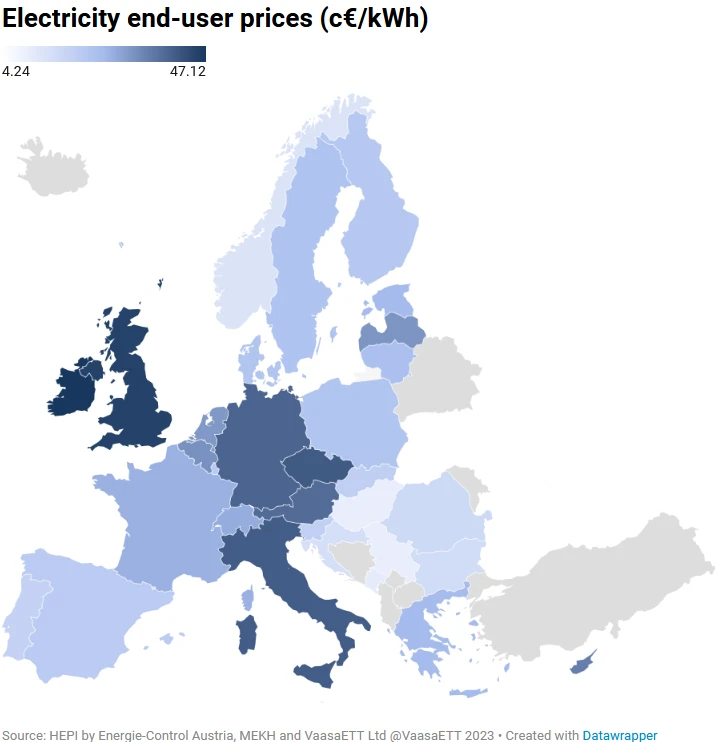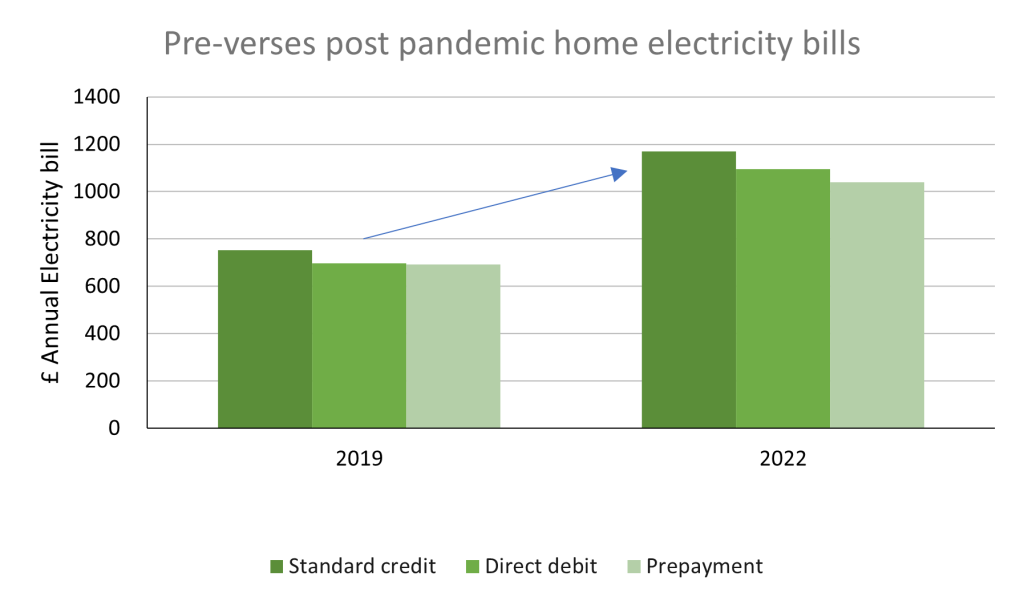Why is electricity so expensive?
Electricity costs remain high worldwide as the persistent energy crisis looms over our fossil fuel-dependent societies.
In this article, we’ll explore why electricity in the UK is persistently more expensive than in other countries and shed light on the recent surge in electricity costs, a development that, in hindsight, was predictable
Shortcuts:
- Why is electricity so expensive in the UK?
- Why is electricity so expensive in the UK compared to Europe?
- What is the current cost of electricity in the UK?
- What has caused the increase in the cost of electricity?
- FAQs
Why is electricity so expensive in the UK?
According to a ranking by GlobalPetrolPrices.com the cost of electricity in the UK is the 9th highest of the 100 ranked nations.
Here are the three long-term factors that contribute to the UK paying one of the most expensive electricity prices in the world:
Lack of energy independence
On a windy day, the grid completely turns off gas-fired power stations. These days, the electricity supplied to businesses and homes is entirely green and produced within the UK. These days provide a glimpse into the future when the UK will have energy independence from other countries and fossil fuels.
Unfortunately, there’s little reliability in British weather.
Most days, the power network relies on gas-fired power plants to provide power when renewable energy generation doesn’t meet demand. In June 2023, 36.9% of electricity was still generated by gas-fired power plants.
The problem is that the UK needs to produce more natural gas. The North Sea was once one of the world’s biggest sources of natural gas, but the output of natural gas has shrunk by two-thirds in the last 20 years.
Due to this decline, the UK imports huge amounts of natural gas through undersea interconnectors and shipments of Liquid Natural Gas (LNG).
This leaves the UK exposed to overseas geopolitical events at these source countries that can cause energy prices to soar. Continue below for the events that have made electricity really expensive in 2022 and 2023.
Renewable electricity pricing
Meanwhile, the UK is gradually decarbonising its power generation to meet>its climate commitments.
According to the BEIS, the UK generated over 25% of its electricity through wind farms in 2022, which must keep growing significantly over the next few years.
The power produced from a wind farm is effectively free, as unlike a nuclear or gas-fired power plant, there is no need to purchase fuel – the wind is free for anyone to use.
Unfortunately, for homes and businesses, this renewable electricity is not actually free. To incentivise developers of UK wind farms to invest their millions in building new turbines, it’s necessary to pay them for the electricity they generate.
In the UK, the electricity price paid to wind farms and other renewable investors is determined by the ‘marginal cost of the last generating unit of power’. Here’s a brief explanation of what this means:
All power generators in the UK continually bid to provide power to the electricity grid. The grid naturally chooses the cheapest bids to fulfil the demand for electricity from one minute to the next.
Here’s the typical order of bids in this process from lowest to highest:
- Renewables will always bid the lowest prices because their electricity uses energy from wind or sun, which is free.
- Nuclear will also bid low. Nuclear power stations are not easily turned off, so they must always produce electricity.
- Gas-fired power plants will be the next significant bidder, but the current price of natural gas will determine their bid price.
On the vast majority of days, gas-power plants will step in to meet the additional demands of the grid after the contribution of renewables and nuclear.
The ‘marginal cost of the last generating unit of power’ means the price of the final accepted bid. The marginal cost is invariably a bid by a gas-fired power plant owner.
This ultimately means that the ‘cost-free’ electricity produced by wind farms is just as expensive as the electricity produced by burning gas. So in the last year, the amounts paid to wind farm owners skyrocketed in step with the rise in the price of natural gas.
Load balancing
The national grid is an electric power transmission network that connects power stations to businesses and households. The network covers the entire country, allowing electricity generated anywhere to be distributed where needed.
A key feature of the British electricity market is extremely limited energy storage. This means that excess electricity generated cannot be stored for future use.
Without the energy storage to support the growing number of renewables, the national grid must rely on more expensive mechanisms to keep the national grid in check.
This careful management is called load rebalancing and requires national grid operators to juggle supply and demand to ensure that the national grid frequency remains as close as possible to 50Hz.
Electrical appliances in the UK are designed to function at this frequency, so any significant deviation from this may be catastrophic, so there are numerous in-built mechanisms to ensure 50Hz is set in stone.
When electricity demand is greater than supply (i.e. on a very cold winter evening), the frequency falls as the power from the grid is drained.
In this case, operators can immediately request idle coal, gas or pumped hydro storage to provide their excess power to the grid.
This idle capacity is contractual, and the operators pay a premium to these power generators to keep this.
The need to constantly re-balancing electricity comes at a cost to homes and businesses that ultimately need to pay for the electricity supply.
Why is electricity so expensive in the UK compared to Europe?
There are a few long-standing reasons for the UK power grid being more exposed to the rising price of gas compared with our fellow European countries:
- Behind the green transition – The UK generates approximately 40% of its electricity from natural gas. In contrast, the average continental European country only generates 20%, with greater reliance on Nuclear and renewable energy sources.
- Lack of gas storage – In 2017, the UK closed Centrica’s Rough storage facility, effectively eliminating the UK’s ability to store natural gas. Without storage, it was necessary to continue to purchase gas at the height of the crisis. To compare, the Netherlands has over nine times and Germany over 16 times the gas storage capacity.
See below an image comparing the electricity price in European countries in June 2022.

Source: Energy Price Index
What is the current cost of electricity in the UK?
Our energy experts provide up-to-date reporting of the cost of electricity in the UK. Here are our key pages:
- Wholesale cost of electricity – The cost of electricity agreed between generators (wind farms, nuclear plants, etc.), traders and suppliers on the national grid. Check out our monthly update on the wholesale cost of electricity on the National Grid.
- Home electricity prices – The cost of electricity supplied to homes depends on government interventions such as the Energy Price Cap and the Energy Price Guarantee. Check out our latest update on home electricity prices.
- Business electricity prices – Our weekly update on the fixed-rate electricity prices available to businesses and other organisations offered by business energy suppliers.
💡Compare business electricity prices for your business today with AquaSwitch.
What is the average UK electricity bill?
The table below shows the average home electricity prices in 2022, assuming an annual consumption of 3,600 kWh, based on the latest government annual domestic energy price statistics.
| Year | Standard credit | Direct debit | Prepayment |
|---|---|---|---|
| 2023 | £1,325 | £1,276 | £1,247 |
What has caused the increase in the cost of electricity?
The cost of electricity has soared to unprecedented levels since 2021. Here are the two factors that explain the recent abrupt increase in the cost of electricity in the UK:
Soaring European gas prices
Throughout the 2010s, Russia supplied Europe with an incredibly cheap supply of natural gas. Natural gas is a by-product of Russia’s massive oil industry, meaning it had a vast excess of natural gas that it exported to Europe using gas pipelines.
Since the conflict in Ukraine, Russia has severely restricted its gas sales into Europe, leading to a severe lack of supply.
European countries have had to rely instead on expensive liquid natural gas (LNG) shipments from America and the Middle East to replace the usually cheap and reliable Russian gas.
Over the last ten years, the average gas price in Europe has been between €5/MWh and € 35/MWh. In August 2022, gas prices hit an all-time high of over €300/MWh. (Source: European council)
The UK gas distribution network is connected to the European network through several undersea pipelines, so our wholesale gas prices always correlate with our European neighbours.
UK’s dependence on European gas for power generation
To meet the UK’s climate commitments, the government is decarbonising the electricity grid, relying on the generation of electricity from wind farms and nuclear. Unfortunately, our green revolution is a ‘work in progress’, and the number one source of electricity still comes from gas power plants.
Until 2020, gas power plants made a lot of sense since natural gas was widely available and incredibly cheap, but the soaring costs of its primary ingredient are making electricity expensive.
Unfortunately, there is no quick and easy way to replace the UK’s reliance on gas-fired power stations. Building a new offshore wind farm or nuclear power station takes decades. Other sources like solar, hydro, biomass power stations and energy storage operate only at low capacities.
The UK’s extraction of natural gas from the North Sea has dwindled over the last twenty years, whilst consumption remains high. For example, most properties use natural gas boilers for heating, despite alternatives like heat pumps being widely available.
Altogether, this means the UK was uniquely vulnerable to the soaring cost of gas pushing up electricity prices for homes and businesses across the country.
And that’s a wrap! If you found this article interesting, look at our blog for more in-depth views and updates on energy, tech, water and telecommunications. Otherwise, here are answers to common FAQs regarding the costs of electricity in the UK:
FAQs
Here are all your frequently asked questions, answered, on the cost of electricity and why it’s so expensive!
How much of an impact has the pandemic had on electricity prices?
Below is a graph comparing pre and post-pandemic home electricity prices.
Even though the cost of electricity rose sharply during this period, it’s not right to blame the pandemic. The effect of the pandemic was to lower the demand for electricity due to the partial shutdown of the industry during the lockdown periods.
According to conventional economics, falling electricity demand will reduce electricity market prices. The real reason for the hike in electricity prices relates to European gas prices (explained above)
For more information, here is the International Energy Agency’s report on the impact of Covid-19 on electricity.

Which region spends the most on electricity?
Merseyside and North Wales have the crown for the most expensive electricity in Britain.
Electricity distribution networks are regional, and this area is particularly expensive due to the sparse population over a large area pushing up the distribution element of electricity bills.
The table below summarises the electricity prices paid per kWh in 2022 by region according to the latest published government statistics.
| Region | Electricity p/kWh |
|---|---|
| Merseyside & North Wales | 37.89 |
| South Scotland | 36.98 |
| South East | 36.27 |
| North Scotland | 36.15 |
| South Wales | 36.11 |
| South West | 36.07 |
| London | 36.05 |
| Southern | 36.02 |
| West Midlands | 35.06 |
| Eastern | 35.03 |
| North West | 34.69 |
| North East | 34.46 |
| Yorkshire | 34.32 |
| East Midlands | 33.97 |
| Northern Ireland | 30.63 |
Are wholesale costs expensive for electricity?
The wholesale cost of electricity per kWh is typically three times more expensive than natural gas.
The cost disparity between electricity and gas per kWh is because the UK uses natural gas to generate electricity.
The process of combusting natural gas into heat to boil water, drive a turbine and generate electricity isn’t wholly efficient, and energy is lost in the process resulting in more expensive wholesale costs for electricity.
Check out our monthly update on wholesale energy prices.

